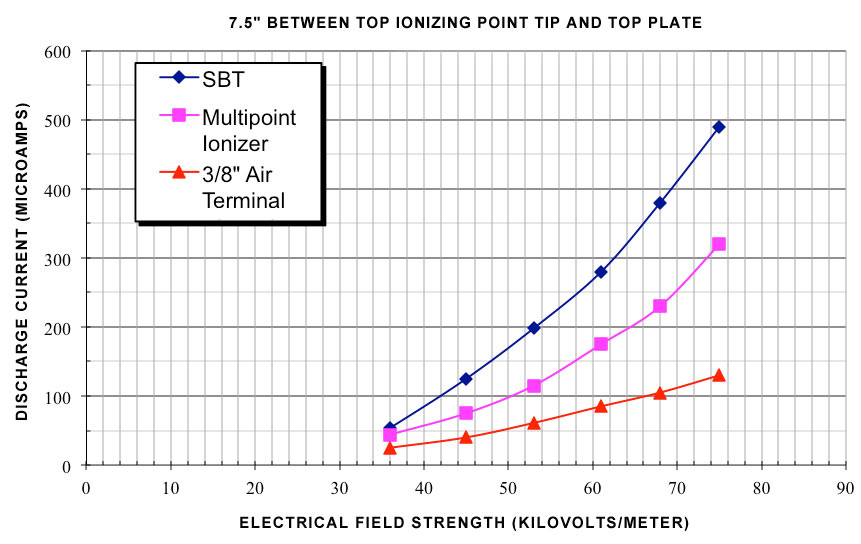CHARGE TRANSFER TECHNOLOGY
Definition of Charge Transfer System
Darwin N. Sletten — August 2012
A Charge Transfer System™ (CTS™) is a system intended to prevent a lightning strike from occurring within a protected zone or area. The CTS collects the induced charge developed by thunderstorm clouds from a designated protected area of the earth and transfers this charge through the ionizer into the surrounding air. The process whereby a sharp point immersed in an electrostatic field transfers charge from the ionizer into the air is known as point discharge. The resulting ionized air molecules form a mixture of charged and uncharged molecules known as space charge, which acts to form a shield between the storm cell and the site. The resulting difference in electrical potential between the protected site and the storm clouds is reduced thereby delaying the formation of an upward streamer from the protected site and preventing direct strikes.
The CTS consists of one or more ionizers, down conductor, and charge collector, as described below.
The charge collector is an interconnected system of grounding electrodes and conductor designed to collect and funnel electrical charge to the ionizers. The down conductor(s) provide the electrical connection between the charge collector and the ionizers. The ionizers provide a means for point discharge to occur.
Depending on the CTS design objectives, the charges transferred to the air can act in one of two modes as follows:
- Collection Mode; establishes a preferred conductive path for the lightning leader.
- Prevention Mode;reduces the electric field intensity to the level that delays the formation of an upward streamer from the protected area.
All LEC lightning prevention products, discussed below, function as CTS.
- Dissipation Array™ System (DAS™); is the name for our patented a CTS. The DAS is designed with a combination of different multipoint ionizers to function in the Prevention Mode.
- SBI's are a multipoint ionizer that can be deployed along with DAS to function in the Prevention Mode. Multiple units of SBIs can be deployed without DAS to function in the CTS Collection Mode. SBI's are normally mounted in groups on elevated structures.
- SBTs are a multipoint ionizer that can be deployed along with DAS to function in the Prevention Mode.; Multiple SBTs can be deployed without DAS to function in the CTS Collection Mode.; SBT's are designed to be placed on roofs and roof projections subject to a direct lightning strike.
- Ion Plasma Generators™ (IPG™) are a multipoint ionizer that functions only in the Collection Mode.
Ionization Current Using Properly Spaced Ionizing Points
Darwin N. Sletten — August 2012
A Spline Ball Terminal™ (SBT™); is a single multipoint ionizer in the Charge Transfer System (CTS) family. Because it is designed with a limited number of ionizing points on the unit, it falls into the collection of CTS operation. If the number of points were increased significantly and distributed effectively over a larger area, it may be classified in the prevention of the CTS. A comparative test was conducted to illustrate the greater ionization capability of the SBT (CTS) with proper point spacing over a single ionizing point air terminal and a multipoint ionizer with close ionizing point spacing.
Testing was performed using the following ionizing point configurations:
- The Spline Ball Terminal (SBT). The SBT has 80 ionizing points which are spaced into a ball with each ionizing point separated from the others by approximately 4 inches.
- Multi ionizing-point ionizer. This ionizer has several hundred ionizing points spaced approximately apart in a hemispheric configuration.
- A single-ionizing-point air terminal (lightning rod Each ionizer was placed in the same test bed with the top ionizing point set 7.5 inches from the positive voltage source.
The voltage was increased to produce a local electric field from 0 to 75 kV/m while the discharge current was measured at each discrete voltage. Measurements were recorded at 6 different voltage levels. The Comparison graph shows a comparison of the discharge current and applied electric field strength for each ionizer.
Comparison of Ionizers
As can be seen above, the SBT generates 2.1 to 3.6 times the ionization current that is generated by the air terminal as the electric field strength increases. Similarly, the SBT generates 1.2 to 1.6 times the ionization current of the closely spaced multipoint ionizer. This test illustrates that the SBT, with optimized point spacing, clearly has superior ionization ability as compared to other multipoint ionizers with close point spacing, and far superior ionization capability over a single-ionizing point.



